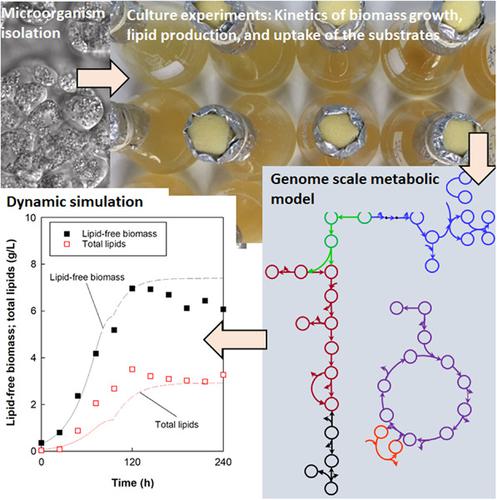当前位置:
X-MOL 学术
›
Biotechnol. Bioeng.
›
论文详情
Our official English website, www.x-mol.net, welcomes your feedback! (Note: you will need to create a separate account there.)
Dynamic flux balance analysis of biomass and lipid production by Antarctic thraustochytrid Oblongichytrium sp. RT2316-13.
Biotechnology and Bioengineering ( IF 3.8 ) Pub Date : 2020-06-18 , DOI: 10.1002/bit.27463 Carolina Shene 1 , Paris Paredes 1 , Liset Flores 1 , Allison Leyton 1 , Juan A Asenjo 2 , Yusuf Chisti 3
Biotechnology and Bioengineering ( IF 3.8 ) Pub Date : 2020-06-18 , DOI: 10.1002/bit.27463 Carolina Shene 1 , Paris Paredes 1 , Liset Flores 1 , Allison Leyton 1 , Juan A Asenjo 2 , Yusuf Chisti 3
Affiliation

|
Production of biomass and lipids in batch cultures of the Antarctic thraustochytrid Oblongichytrium sp. RT2316‐13, is reported. The microorganism proved capable of producing nearly 67% docosahexaenoic acid (DHA) and 15% eicosapentaenoic acid (EPA) in its total lipid fraction. Biomass with a maximum total lipid content of 33.5% (wt/wt) could be produced at 15°C in batch culture using a medium containing glucose (20 g/L), yeast extract (10.5 g/L), and other minor components. A lower culture temperature (5°C) reduced biomass and lipid productivities compared to culture at 15°C, but enhanced the DHA and EPA content of the lipids by 6.4‐ and 3.3‐fold, respectively. Both a simple minimally structured mathematical model and a more complex genome‐scale metabolic model (GEM) allowed the fermentation profiles in batch cultures to be satisfactorily simulated, but the GEM provided much greater insight in the biochemical and physiological phenomena underlying the observed behavior. Unlike the simpler model, the GEM could be interrogated for the possible effects of various external factors such as oxygen supply, on the expected outcomes. In silico predictions of oxygen effects were consistent with literature observations for DHA producing thraustochytrids.
中文翻译:

南极破囊壶菌 Oblongichytrium sp. 生物量和脂质生产的动态通量平衡分析。RT2316-13。
在南极破囊壶菌 Oblongichytrium 的分批培养中生产生物量和脂质sp. RT2316-13,报道。该微生物证明能够在其总脂质部分中产生近 67% 的二十二碳六烯酸 (DHA) 和 15% 的二十碳五烯酸 (EPA)。使用含有葡萄糖 (20 g/L)、酵母提取物 (10.5 g/L) 和其他微量成分的培养基,在 15°C 下分批培养可以产生最大总脂质含量为 33.5% (wt/wt) 的生物质. 与 15°C 培养相比,较低的培养温度 (5°C) 降低了生物量和脂质生产率,但脂质的 DHA 和 EPA 含量分别提高了 6.4 倍和 3.3 倍。简单的最小结构数学模型和更复杂的基因组规模代谢模型(GEM)都可以令人满意地模拟分批培养中的发酵曲线,但是 GEM 对所观察到的行为背后的生化和生理现象提供了更深入的了解。与更简单的模型不同,可以询问 GEM 以了解各种外部因素(如氧气供应)对预期结果的可能影响。对氧效应的计算机模拟预测与文献中关于产生 DHA 的破囊壶菌的观察结果一致。
更新日期:2020-06-18
中文翻译:

南极破囊壶菌 Oblongichytrium sp. 生物量和脂质生产的动态通量平衡分析。RT2316-13。
在南极破囊壶菌 Oblongichytrium 的分批培养中生产生物量和脂质sp. RT2316-13,报道。该微生物证明能够在其总脂质部分中产生近 67% 的二十二碳六烯酸 (DHA) 和 15% 的二十碳五烯酸 (EPA)。使用含有葡萄糖 (20 g/L)、酵母提取物 (10.5 g/L) 和其他微量成分的培养基,在 15°C 下分批培养可以产生最大总脂质含量为 33.5% (wt/wt) 的生物质. 与 15°C 培养相比,较低的培养温度 (5°C) 降低了生物量和脂质生产率,但脂质的 DHA 和 EPA 含量分别提高了 6.4 倍和 3.3 倍。简单的最小结构数学模型和更复杂的基因组规模代谢模型(GEM)都可以令人满意地模拟分批培养中的发酵曲线,但是 GEM 对所观察到的行为背后的生化和生理现象提供了更深入的了解。与更简单的模型不同,可以询问 GEM 以了解各种外部因素(如氧气供应)对预期结果的可能影响。对氧效应的计算机模拟预测与文献中关于产生 DHA 的破囊壶菌的观察结果一致。


























 京公网安备 11010802027423号
京公网安备 11010802027423号